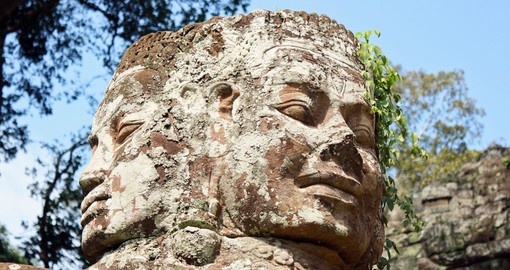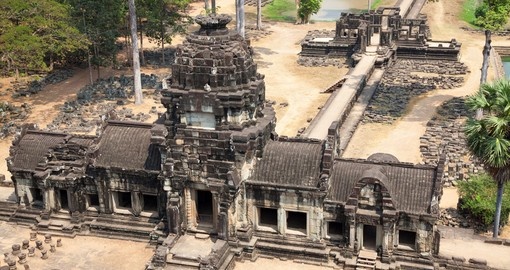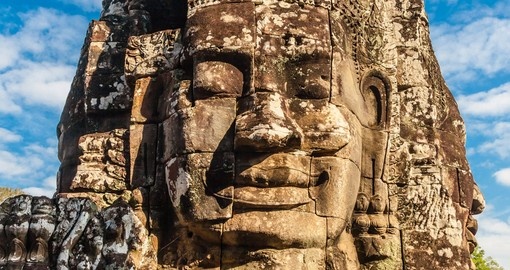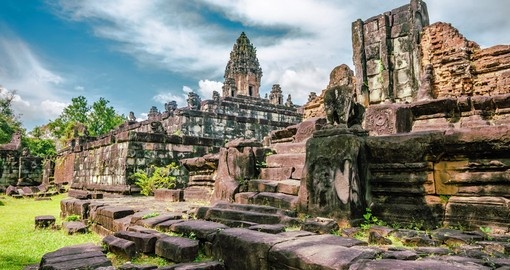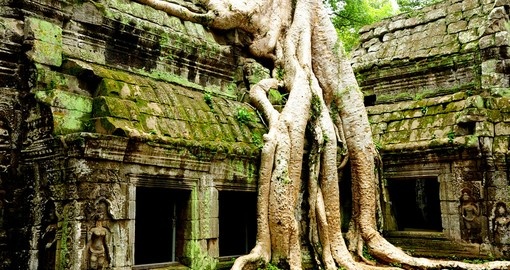Cambodia History
The oldest Indianised state in Southeast Asia, Funan, existed in Cambodia from the first to the sixth centuries and saw the beginnings of the Cambodian language and religion develop. After the Fun on the state came the Angkor Empire which flourished for the next 600 years, expanding and controlling much of Southeast Asia from Myanmar in the east to the South China Sea and north to Laos. It was during this time that the Angkor Temple Complex was built - the most extensive concentration of religious temples in the world. The decline of the Angkor Empire happened in the 13th and 14th centuries although historians are unable to fully explain why, however, theories suggest it was down to the rise of powerful Thai kingdoms. The decline led to a period known as the Dark Ages in Cambodia that lasted for another four centuries. Not much is known about this time except that the Cambodian language and cultural identity remained intact despite frequent invasions.
The late 18th century saw civil wars in Vietnam spill into Cambodia devastating the country. As a result of this devastation, Thailand and Vietnam competed to gain control of Cambodia. France began to show colonial interest in the country and in 1863 Cambodia became a protectorate thwarting interest from Thailand and Vietnam. France ruled for the next ninety years but left institutions like the monarchy in place and developed civil services. They also restored the Angkor Temple Complex and in turn restored pride to Cambodians.
As Cold War tensions began to mount in Asia, Cambodia was able to peacefully secure independence at the hands of King Sihanouk in 1953. He maintained a position of neutrality despite much courting from key Cold War countries who were hoping to secure support in Cambodia. This courting resulted in great financial gain for the nation.
In 1965, King Sihanouk broke off diplomatic ties with the United States and as the war intensified in Vietnam, so too did opposition to the king. By supporting North Vietnam, the country entered a great economic decline and the king was forced to renew relations with the US. 1970 saw Sihanouk deposed while he was abroad and the prime minister, Lon Noi, formed a new government called the Khmer Republic. At the same time, a resistance group that was allied with North Vietnam called Knhmer Rouge also formed. The control of the Khmer Rouge came to Pol Pot, a Communist guerilla commander while Sihanouk remained in exile. By 1975, the Khmer Republic fell allowing Pol Pot to establish a brutal regime that lasted until 1978.
The Khmer Rouge forced city dwellers, whom they viewed as a threat, into agricultural labour. They restricted freedom of speech, movement and religion and killed intellectuals, merchants, bureaucrats as well as prominent religious leaders. Approximately 1.7 million people, about one-fifth of the population, were killed by the end of 1978 when the Khmer Rouge collapsed after an invasion by the Socialist Republic of Vietnam, however, they remained a resistance movement until the 1990s.
The following years saw more political turmoil and the Vietnamese occupation of Cambodia. However, in 1991 the UN and other interested parties signed an agreement in Paris to try to end the conflict in Cambodia. An election was held in 1993 and the government ratified a new constitution restoring the monarchy and establishing the Kingdom of Cambodia. Sihanouk was again named king. Pol Pot died in 1998 and by early 1999, most of the remaining Khmer Rouge troops and leaders surrendered. Two of these leaders were arrested and charged with genocide. The recovery period in Cambodia has faced many challenges, including a coup attempt in 1997, however, it has also seen progress in economic and personnel areas. Trade has increased and Cambodia has become an interesting travel destination for those wishing to learn about the immense history of this fascinating country.
Cambodia Travel Information
At Goway we believe that a well-informed traveller is a safer traveller. With this in mind, we have compiled an easy-to-navigate travel information section dedicated to Cambodia.
Learn about the history and culture of Cambodia, the must-try food and drink, and what to pack in your suitcase. Read about Cambodia's nature and wildlife, weather and geography, along with 'Country Quickfacts' compiled by our travel experts. Our globetrotting tips, as well as our visa and health information, will help ensure you're properly prepared for a safe and enjoyable trip. The only way you could possibly learn more is by embarking on your journey and discovering Cambodia for yourself. Start exploring… book one of our Cambodia tours today!
Extend Your Trip
After your Cambodia vacation, consider taking the time to visit other destinations. Goway offers exciting China vacation packages, India tours and Thailand vacation packages plus a comprehensive selection of vacation packages in many other Asian countries.
Book your Cambodia tour with Goway!
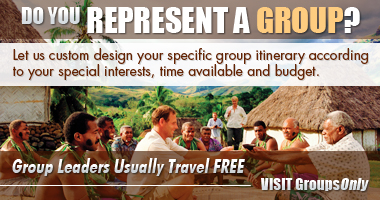 ASIA by Goway is an exclusive division that specializes in planning and organizing Cambodia tours, vacations and experiences. Choose from a simple city stopover, see the country highlights on one of our classic itineraries, enjoy a small group tour and much more. We want to be your first choice when next you go globetrotting to Cambodia.
ASIA by Goway is an exclusive division that specializes in planning and organizing Cambodia tours, vacations and experiences. Choose from a simple city stopover, see the country highlights on one of our classic itineraries, enjoy a small group tour and much more. We want to be your first choice when next you go globetrotting to Cambodia.
Get a Trip Quote Order a Brochure







